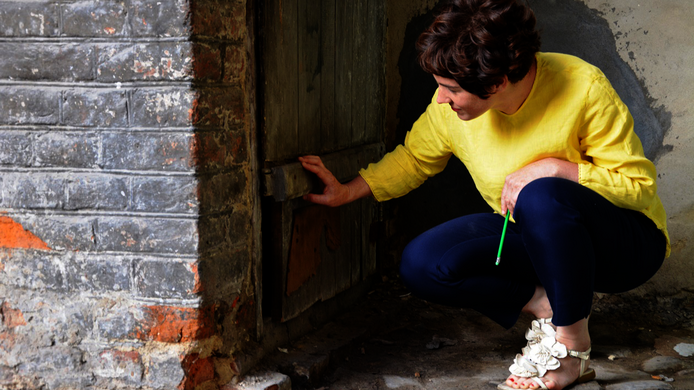How a smell may evolve into a stink

The Polish perfume brand “Pani Walewska” has cult status: in the 1970s the cosmetics sector flourished in the People's Republic of Poland. Alongside French scents and Soviet products, several Polish perfume lines were tokens of a new prosperity. “When perfumes were mentioned in interviews, there were always value judgments resonating between the lines. Soviet perfumes for women generally had a 'bad reputation' in Poland, for instance. They were often described as better insecticides’, which implicitly expressed the mixed feelings people had about the Soviet Union,” notes cultural scholar Stephanie Weismann from the Department of Eastern European History at the University of Vienna. Weismann, who holds a Firnberg fellowship from the Austrian Science Fund FWF, is conducting research into how odours were perceived and handled in Lublin, Poland, throughout the 20th century, based on selected case-studies. Among others, about the “smellscape” of the Polish bathroom during the Cold War and the years of transformation around 1989 with items such as cosmetics and household chemicals. Weismann conducts her research through sources such as archival documents, press reports and Internet forums, also, she conducted around 60 narrative interviews with contemporary witnesses born between 1950 and 1975. With her focus on an Eastern European city, Weismann broke new ground. Previously, research on sensory history has concentrated mainly on Western European and transatlantic cities and the 19th century. The interdisciplinary research approach of Sensory Studies focuses, among others, on sensory perceptions, in this case the olfactory perception of places, objects, cultural practices and people. They are important because odours strongly shape social and cultural classifications, such as notions of “urban” versus “provincial” or “we” versus “the others”. Smells and our memories of them also tell us a lot about self-images, as well as about feelings of affiliation or resentment.
Life’s venues as a source of knowledge
In this context, the bathroom and its smellscape serve as an olfactory barometer of socio-political changes. In addition to locally produced goods, the smells of imported consumer products from the so-called “West” increasingly made an appearance. “Detergents and soaps from both parts of the divided Germany were particularly popular and shaped the perception of ‘the West’. The Omo detergent brand and the Fa soap held promise and allure, their scents offering room for all kinds of projections,” explains Weismann. The impending overall social and political change was already “in the air”, in a manner of speaking.
In her research project on the olfactory history of Lublin, which is representative also of other Eastern Central European cities, Weismann studies not only the bathrooms of the transformation years, but also the city’s yards during the interwar period, among other case studies. These “spatial-temporal sniffs” or “olfactory deep drilling”, as the researcher puts it, provide new insights into the social and cultural history of the 20th century. Weismann’s aim is to find out two things: firstly, how political, social, cultural and economic structures and processes in Eastern Central Europe have been transformed into perceptible olfactory experiences. Secondly, how changing olfactory landscapes, or “smellscapes”, and especially their perception, can be used to draw conclusions about socio-cultural mind-sets and sensitivities.
Quite ok yesterday, intolerable today
“Smells have a great impact on people and are very strongly linked with emotions. Accounts of olfactory experiences give us researchers more direct access to social reality,” explains Weismann. The inner-city yards in Lublin, for example, are particularly revealing, along with the complaints of residents. Weismann describes how the perception of odours there changed in the interwar period. The central sources for her case study are documents from the sanitary commission (reports, complaints) as well as local daily newspapers. And these were the smells back then: a blend of kitchen wastes, animal and human faeces, as well as organic waste from local crafts and trades such as private slaughterhouses or leather goods production. In addition, farm animals such as pigs or chickens were still often kept in the yard. During the first half of the 20th century, very little changed with regard to these practices and the very smellscapes themselves. What did change, however, was the way the inhabitants perceived these smellscapes. “Suddenly these conditions literally got up peoples’ noses, and there was a veritable explosion of complaints, requests and inquiries, and an increase in denunciations,” notes the researcher. This development is closely linked to the political and social changes occurring at the time.
Do national aspirations and social advancement make people more sensitive to smells?
With the proclamation of the Second Polish Republic after the end of the First World War, popular pride in nationality and citizenship boomed in Poland. In the same year, Lublin became the capital of the voivodship. Many people now felt themselves to be urbanites, and the familiar smells of a city yard were now perceived as backward and provincial. People also turned up their noses at other things: Jewish fellow citizens increasingly became the object of olfactory resentment. “The new complaints about olfactory grievances not only provide information about living conditions and neighbourly relations but also reflect socio-political sensitivities and dissatisfaction,” Weismann notes. “The sudden demand for fresh air and the deprecation of previous conditions are also a product of democratic developments.” The end of censorship gave rise to local newspapers representing a wide range of ideologies – and, thus, vigorous expression of opinions and resentments. In this context, also the new right to make complaints was eagerly embraced. The basic research project, which will run until 2022, illustrates the relevance of olfactory perception for research into urban history. It will thus become clear to what extent socio-cultural changes are also reflected in the daily life of the individual. On the other hand, the olfactory atmosphere of a city, whether perceived as a malodorous or scented, reflects not only everyday life in this city but also its social and cultural history.
Personal details Stephanie Weismann is a Hertha-Firnberg Fellow and principal investigator of this project at the Department of East European History at the University of Vienna. Her research interests include sensory history, the social and cultural history of Eastern Central Europe and Russia in the 19th and 20th centuries with a focus on everyday history and also popular culture during and after socialism. With her research on the smellscapes of Lublin she is also involved in the interdisciplinary Research Center for the History of Transformations RECET.
Publications






